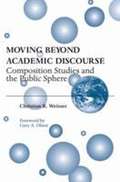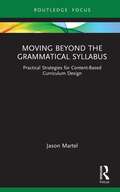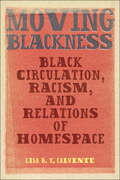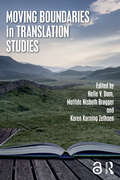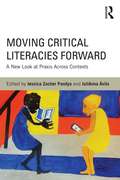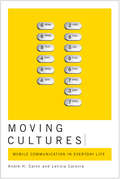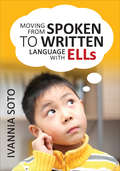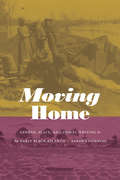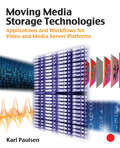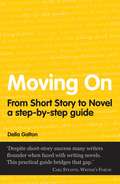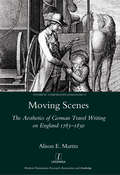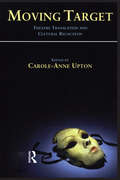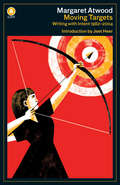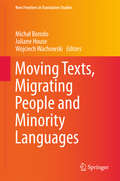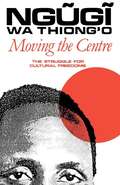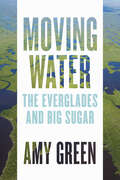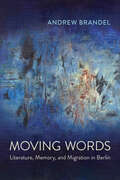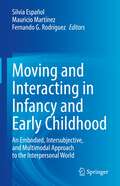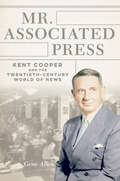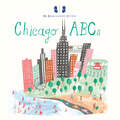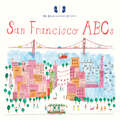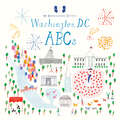- Table View
- List View
Moving Beyond Academic Discourse: Composition Studies And The Public Sphere
by Christian R. WeisserMoving student writing beyond academic discourse and into larger public spheres is a difficult task, but Christian R. Weisser’s study challenges composition instructors to do just that. This highly accessible book does what no other study has attempted to do: place the most current, cutting-edge theories and pedagogies in rhetoric and composition in their intellectual and historical contexts, while at the same time offering a unique, practical theory and pedagogy of public writing for use both inside and outside of the classroom. By positing a theory of the public for composition studies, one which envisions the public sphere as a highly contested, historically textured, multilayered, and sometimes contradictory site, Weisser offers a new approach to the roles that compositionists might assume in their attempts to initiate progressive political and social change. After first providing a historical context that situates composition’s recent interest in public writing, Weisser next examines recent theories in composition studies that consider writing an act of social engagement before outlining a more complex theory of the public based on the work of Jürgen Habermas. The resulting re-envisioning of the public sphere expands current conversations in rhetoric and composition concerning the public. Weisser concludes with a holistic vision that places greater political and social import on addressing public issues and conversations in the composition classroom and that elucidates the role of the public intellectual as it relates specifically to compositionists in postmodern society.
Moving Beyond the Grammatical Syllabus: Practical Strategies for Content-Based Curriculum Design (Routledge Focus on Applied Linguistics)
by Jason MartelIn this concise and practical book, Martel advocates for a content-based approach to foreign language curriculum design that emphasizes communicative competence, cognitive engagement, and social justice. Intended primarily for busy teachers with limited preparation time, the book includes: An introduction to content-based instruction and its use to date in foreign language education Step-by-step strategies for designing content-based unit plans, lesson plans, and assessments A complete curricular unit that serves as a guiding example, including nine lesson plans and a summative assessment The book is accompanied by a website that will feature additional examples of content-based curricular materials across a range of languages and proficiency levels, available at http://cbi.middcreate.net/movingbeyond.
Moving Blackness: Black Circulation, Racism, and Relations of Homespace
by Lisa B. CalventeMoving Blackness: Black Circulation, Racism, and Relations of Homespace delves into the intricate connections between communication, culture, power, and racism in relation to blackness. Through a blend of interviews, oral histories, and meticulous archival research, this book sheds light on the multifaceted narratives surrounding Black identity. It explores how these stories circulate, serving as tools of resistance, negotiation, and affirmation of diverse manifestations and representations of blackness. By emphasizing the significance of storytelling as a means through which blackness affirms itself, transcending time and space, the book underscores how communicative embodiments of Black identity enable individuals to persevere within marginalized contexts. Engaging with theories of anti-Black racism, modernity, coloniality, and the Black diaspora, the book frames storytelling and the circulation of narratives as performances deeply rooted in the everyday lives of Black people across the diaspora. Starting with an examination of the racial construction of movement during colonialism and slavery, the book traces how this history shapes contemporary interactions. With its exploration of how Black circulation transforms movement and space, the book introduces a forward-thinking approach to the Black diaspora, anchored in a politics of identification rather than being confined to the past or a specific location. Moving Blackness argues that the desire for homespace, a yearning for belonging that transcends any particular physical space, fuels this envisioned future, rooted in the historical and material conditions of racism and marginalization.
Moving Boundaries in Translation Studies
by Helle V. Dam Matilde Nisbeth Brøgger Karen Korning ZethsenTranslation is in motion. Technological developments, digitalisation and globalisation are among the many factors affecting and changing translation and, with it, translation studies. Moving Boundaries in Translation Studies offers a bird’s-eye view of recent developments and discusses their implications for the boundaries of the discipline. With 15 chapters written by leading translation scholars from around the world, the book analyses new translation phenomena, new practices and tools, new forms of organisation, new concepts and names as well as new scholarly approaches and methods. This is key reading for scholars, researchers and advanced students of translation and interpreting studies.
Moving Critical Literacies Forward: A New Look at Praxis Across Contexts
by Jessica Pandya JuliAnna ÁvilaTaking the pulse of current efforts to do—and, in some cases, undo—critical literacy, this volume explores and critiques its implementation in learning contexts around the globe. An impressive set of international authors offer examples of productive critical literacy practices in and out of schools, address the tensions and gaps between these practices and educational policies, and attempt to forecast the future for critical literacy as a movement in the changing global educational policy landscape. This collection is unique in presenting the recent work of luminaries such as Allan Luke and Hilary Janks alongside relative newcomers who use innovative approaches and arguments to reinvigorate and redefine critical practice. It is time for this cutting-edge inquiry into the state of critical literacy—not only because is it a complex and ever-evolving field, but perhaps more important, because it offers a reaction to, and powerful reworking of, standardization and high-stakes accountability measures in educational contexts around the globe.
Moving Cultures
by Letizia Caronia André H. CaronAndré Caron and Letizia Caronia look at teenagers' use of text messaging to chat, flirt, and gossip. They find that messaging among teens has little to do with sending shorthand information quickly. Instead, it is a verbal performance through which young people create culture. Moving Cultures argues that teenagers have domesticated and reinterpreted this technology.
Moving From Spoken to Written Language With ELLs
by Ivannia SotoMastering spoken language is the key to writing success for English language learners English language learners struggle to meet the increased classroom writing demands of the Common Core State Standards, and many schools seem at a loss for solutions. In these pages, ELL expert Ivannia Soto builds on the groundbreaking research she presented in her previous book ELL Shadowing as a Catalyst for Change to show how oral language development scaffolds writing skills. To implement this knowledge, Soto offers educators a powerful set of tools: • Exciting spoken techniques such as Socratic Seminar, Frayer model and Think-Pair-Share that build vocabulary and extend into academic writing • Approaches to teaching three essential styles of writing: argumentative, procedural, and narrative • Sample lesson plans and graphic organizer templates ELLs must develop oral language skills before meeting the Common Core’s writing requirements. This book provides the tools to make this happen. "This timely book collects oral language strategies designed to scaffold academic writing for English language learners at intermediate and advanced levels of English proficiency. Concrete examples support the goal of teaching college and career ready standards across content areas." —Charlene Rivera, Research Professor The George Washington University Center for Equity and Excellence in Education
Moving From Spoken to Written Language With ELLs
by Ivannia SotoMastering spoken language is the key to writing success for English language learners English language learners struggle to meet the increased classroom writing demands of the Common Core State Standards, and many schools seem at a loss for solutions. In these pages, ELL expert Ivannia Soto builds on the groundbreaking research she presented in her previous book ELL Shadowing as a Catalyst for Change to show how oral language development scaffolds writing skills. To implement this knowledge, Soto offers educators a powerful set of tools: • Exciting spoken techniques such as Socratic Seminar, Frayer model and Think-Pair-Share that build vocabulary and extend into academic writing • Approaches to teaching three essential styles of writing: argumentative, procedural, and narrative • Sample lesson plans and graphic organizer templates ELLs must develop oral language skills before meeting the Common Core’s writing requirements. This book provides the tools to make this happen. "This timely book collects oral language strategies designed to scaffold academic writing for English language learners at intermediate and advanced levels of English proficiency. Concrete examples support the goal of teaching college and career ready standards across content areas." —Charlene Rivera, Research Professor The George Washington University Center for Equity and Excellence in Education
Moving Home: Gender, Place, and Travel Writing in the Early Black Atlantic (Next Wave: New Directions in Women's Studies)
by Sandra GunningIn Moving Home, Sandra Gunning examines nineteenth-century African diasporic travel writing to expand and complicate understandings of the Black Atlantic. Gunning draws on the writing of missionaries, abolitionists, entrepreneurs, and explorers whose work challenges the assumptions that travel writing is primarily associated with leisure or scientific research. For instance, Yoruba ex-slave turned Anglican bishop Samuel Ajayi Crowther played a role in the Christianization of colonial Nigeria. Sarah Forbes Bonetta, a formerly enslaved girl "gifted" to Queen Victoria, traveled the African colonies as the wife of a prominent colonial figure and under the protection of her benefactress. Alongside Nancy Gardiner Prince, Martin R. Delany, Robert Campbell, and others, these writers used their mobility as African diasporic and colonial subjects to explore the Atlantic world and beyond while they negotiated the complex intersections between nation and empire. Rather than categorizing them as merely precursors of Pan-Africanist traditions, Gunning traces their successes and frustrations to capture a sense of the historical and geographical specificities that shaped their careers.
Moving Media Storage Technologies: Applications & Workflows for Video and Media Server Platforms
by Karl PaulsenComplex media storage computer systems are employed by broadcasters, digital cinemas, digital signage, and other business and entertainment venues to capture, store and retrieve moving media content on systems that will preserve the original integrity of the content over time and technological transition. This book provides detailed information related to the concepts, applications, implementation and interfaces of video file servers, intelligent storage systems, media asset management services, content distribution networks, and mission critical platforms. A tutorial and case example approach is taken to facilitate a thorough understanding of the technologies, using numerous illustrations, tables and examples. The text and appendices are designed to provide easy to access valuable reference and historical information. .A focus on the media serving concepts and principles employed at the enterprise level .Practical and technological summaries of the applications and linkages between media asset management and storage technologies for studio, television, and media production workflows .Illustrations, standards, tables, and practical summaries serve as handy reference tools
Moving On
by Della GaltonYou are writing and selling short stories but you want to take the next step and write a novel. Della Galton, author of the successful writing guide How To Write and Sell Short Stories, shows you how to make the leap in this step-by-step guide. Using examples from her own successful career as writer of hundreds of published short stories and two novels, Della shows the critical differences between developing character, plot and setting in short and long fiction. The essential book to help take your writing to the next level.
Moving Scenes: The Aesthetics of German Travel Writing on England 1783-1820
by Alison E. Martin"Accounts of travel to England reached unprecedented levels of popularity in the German states in the late eighteenth and early nineteenth centuries. Competition therefore increased for travel writers to produce travelogues which offered the most authentic, original and vibrant picture of England. The wider range of narrative strategies which travellers consequently deployed increasingly drew on the emotional responses of their audience - whether to serve a political purpose, show concern for the darker side to the Industrial Revolution or simply demonstrate the humanitarian interests of the travellers themselves. In this broad-ranging study, Alison E. Martin draws on a variety of travellers, men and women, canonical and forgotten, to chart the fascinating variety of styles and approaches which mark this highly interdisciplinary genre."
Moving Target: Theatre Translation and Cultural Relocation
by Carole-Anne UptonMoving Target offers a rigorous exploration of the practice of translating for the theatre. The twelve essays in the volume span a range of work from Eastern and Western Europe, Canada and the United States. For the first time, this book draws together existing translation theory with contemporary practice to shed light on a hitherto neglected aspect of the production process. How does the theatre translator mediate between source text, performance text and target audience? What happens when theatre is transposed from one culture to another? What are the obstacles to theatre translation, and what are the opportunities? Central to the debate throughout is the role of the translator in creating not only a linguistic text but also a performance text, as the contributors repeatedly demonstrate an illuminating sensibility to the demands and potential of theatre production. Impacting upon areas of (inter)cultural theory as well as theatre studies and translation studies, the result is a startling revelation of the joys, as well as the frustrations of the dramatic art of the translator for performance.
Moving Targets: Writing with Intent 1982 - 2004
by Margaret AtwoodThe companion volume to the recently reissued Second Words, Moving Targets is an essential collection of critical prose by Margaret Atwood, now available in a handsome new A List edition. The most precious treasure of this collection is that it gives us the rich back-story and diverse range of influences on Margaret Atwood’s work. From the aunts who encouraged her nascent writing career to the influence of George Orwell’s Nineteen Eighty-Four on The Handmaid’s Tale, we trace the movement of Atwood’s fertile and curious mind in action over the years.Atwood’s controversial political pieces, “Napoleon’s Two Biggest Mistakes” and “Letter to America” — both not-so-veiled warnings about the repercussions of the war in Iraq — also appear, alongside pieces that exhibit her active concern for the environment, the North, and the future of the human race. Atwood also writes about her peers: John Updike, Marina Warner, Italo Calvino, Marian Engel, Toni Morrison, Angela Carter, Gabriel Garcia Marquez, Mordecai Richler, Elmore Leonard, and Ursula Le Guin.This is a landmark volume from a major writer whose worldwide readership is in the millions, and whose work has influenced and entertained generations. Moving Targets is also the companion volume to the recently reissued Second Words.
Moving Texts, Migrating People and Minority Languages
by Juliane House Michał Borodo Wojciech WachowskiIn an age of migration, in a world deeply divided through cultural differences and in the context of ongoing efforts to preserve national and regional traditions and identities, the issues of language and translation are becoming absolutely vital. At the heart of these complex, intercultural interactions are various types of agents, intermediaries and mediators, including translators, writers, artists, policy makers and publishers involved in the preservation or rejuvenation of literary and cultural repertoires, languages and identities. The major themes of this book include language and translation in the context of migration and diasporas, migrant experiences and identities, the translation from and into minority and lesser-used languages, but also, in a broader sense, the international circulation of texts, concepts and people. The volume offers a valuable resource for researchers in the field of translation studies, lecturers teaching translation at the university level and postgraduate students in translation studies. Further, it will benefit researchers in migration studies, linguistics, literary and cultural studies who are interested in learning how translation studies relates to other disciplines.
Moving The Centre: The Struggle For Cultural Freedoms
by Ng 361 G 297 Wa Thiong'OIn this collection Ngugi is concerned with moving the centre in two senses - between nations and within nations - in order to contribute to the freeing of world cultures from the restrictive walls of nationalism, class, race and gender Between nations the need is to move the centre from its assumed location in the West to a multiplicity of spheres in all the cultures of the world. Within nations the move should be away from all minority class establishments to the real creative centre among working people in conditions of racial, religious and gender equality.
Moving Water: The Everglades and Big Sugar
by Amy GreenA riveting story of environmental disaster and political intrigue, Moving Water exposes how Florida's clean water is threatened by dirty power players and the sugar cane industry.Only a century ago, nearly all of South Florida was under water. The Everglades, one of the largest wetlands in the world, was a watery arc extending over 3 million acres. Today, that wetland ecosystem is half of its former self, supplanted by housing for the region's exploding population and over 700,000 acres of crops, including the nation's largest supply of sugar cane. Countless canals, dams, and pump stations keep the trickle flowing, but rarely address the cascade of environmental consequences, including dangerous threats to a crucial drinking water source for a full third of Florida's residents. In Moving Water, environmental journalist Amy Green explores the story of unlikely conservation heroes George and Mary Barley, wealthy real estate developers and champions of the Everglades, whose complicated legacy spans from fisheries in Florida Bay to the political worlds of Tallahassee and Washington. At the center of their surprising saga is the establishment and evolution of the Comprehensive Everglades Restoration Plan (CERP), a $17 billion taxpayer-funded initiative aimed at reclaiming this vital ecosystem. Green explains that, like the meandering River of Grass, the progress of CERP rarely runs straight, especially when it comes up against the fierce efforts of sugar-growing interests, or "Big Sugar," to obstruct the cleanup of fertilizer runoff wreaking havoc with restoration. This engrossing exposé tackles some of the most important issues of our time: Is it possible to save a complex ecosystem such as the Everglades—or, once degraded, are such ecological wonders gone forever? What kind of commitments—economic, scientific, and social—will it take to rescue our vulnerable natural resources? What influences do special interests wield in our everyday lives, and what does it take to push real reform through our democracy? A must-read for anyone fascinated by stories of political intrigue and the work of environmental crusaders like Erin Brockovich, as well as anyone who cares about the future of Florida, this book reveals why the Everglades serve as a model—and a warning—for environmental restoration efforts worldwide.
Moving Words: Literature, Memory, and Migration in Berlin (Anthropological Horizons)
by Andrew BrandelIn the decades since the fall of the Berlin Wall, Berlin has re-emerged as a global city in large part thanks to its reputation as a literary city – a place where artists from around the world gather and can make a life. Moving Words foregrounds the many contexts in which life in the city of Berlin is made literary – from old neighbourhood bookshops to new reading circles, NGOs working to secure asylum for writers living in exile to specialized workshops for young migrant poets. Highlighting the differences, tensions, and contradictions of these scenes, this book reveals how literature can be both a site of domination and a resource for resisting and transforming those conditions. By attending to the everyday lives of writers, readers, booksellers, and translators, it offers a crucial new vantage point on the politics of difference in contemporary Europe, at a moment marked by historical violence, resurgent nationalism, and the fraught politics of migration. Rooted in ethnographic fieldwork, rich historical archives, and literary analysis, Moving Words examines the different claims people make on and for literature as it carries them through the city on irregular and intersecting paths. Along the way, Brandel offers a new approach to the ethnography of literature that aims to think anthropologically about crossings in time and in space, where literature provides a footing in a world constituted by a multiplicity of real possibilities.
Moving and Interacting in Infancy and Early Childhood: An Embodied, Intersubjective, and Multimodal Approach to the Interpersonal World
by Silvia Español Mauricio Martínez Fernando G. RodríguezThis book introduces studies on infant and early childhood development that are in a permanent dialogue with the psychology of music, the philosophy of mind, and human movement studies. They are based on an innovative framework that combines embodied cognition, the multimodal approach to child development, and the second-person perspective in social cognition. This frame of reference allows authors to revisit relevant topics in developmental psychology, such as adult-infant interactions; early intersubjective experiences; the development of perceptual, verbal and gestural communication skills; as well as the complexity of play in infancy and early childhood.In the field of infancy and early childhood studies, the three viewpoints brought together in this volume had a clear innovative impact. Embodied psychology showed the body to be the primary agent in the interactions that shape the infant's psyche. The second-person perspective exhibited the direct, transparent, I-Thou contact involved in the first patterns of reciprocity between adult and infant, and the multimodal theory of perceptual development revealed an infant immersed in a multisensory environment conveying information to all perceptual systems as a unified experience. The studies presented in this volume combine these three viewpoints and link them through the use of analytical tools and concepts from the temporal arts (music and dance). This way of conducting empirical research on some central topics in early infancy led to an aesthetic conception of development that emphasizes bodily experience, temporal affects and their intertwining with symbolic capacitiesMoving and Interacting in Infancy and Early Childhood: An Embodied, Intersubjective, and Multimodal Approach to the Interpersonal World will provide innovative tools for developmental and cognitive psychologists studying the development of early socio-cognitive skills in infants and young children, and will also serve as a rich source of information for researchers and practitioners in other fields, such as education and nursing, who can benefit from cutting-edge knowledge in developmental sciences.
Moyers on America: A Journalist and His Times
by Bill MoyersThe Peabody Award–winning journalist shares stories and insights into our country and the crises we face in an &“eloquent selection of . . . commentaries&” (Publishers Weekly, starred review). Millions of Americans have invited Bill Moyers into their homes over the years. With television programs covering topics from American history, politics, and religion to the role of media and the world of ideas, he has become one of America&’s most trusted journalists. Now Moyers presents, for the first time, a powerful statement of his own personal beliefs—political and moral. Combining illuminating forays into American history with candid comments on today&’s politics, Moyers delivers perceptive and trenchant insights into the American experience. From his early years as a Texas journalist to his role as a founding organizer of the Peace Corps, top assistant to President Lyndon Johnson, publisher of Newsday, senior correspondent and analyst for CBS News, and producer of many of public television&’s groundbreaking series, Moyers has been actively engaged in some of the most volatile episodes of the past fifty years. Drawing from these experiences, he shares his unique understanding of American politics and an enduring faith in the nation&’s promise and potential. Whether reflecting on today&’s media climate, corporate scandals, or religious and political upheavals, Moyers on America recovers the hopes of the past to establish their relevance for the present. &“Not only a good reporter . . . a first-rate storyteller.&” —The Boston Globe
Mr. Associated Press: Kent Cooper and the Twentieth-Century World of News (The History of Media and Communication)
by Gene AllenBetween 1925 and 1951, Kent Cooper transformed the Associated Press, making it the world’s dominant news agency while changing the kind of journalism that millions of readers in the United States and other countries relied on. Gene Allen’s biography is a globe-spanning account of how Cooper led and reshaped the most important institution in American--and eventually international--journalism in the mid-twentieth century. Allen critically assesses the many new approaches and causes that Cooper championed: introducing celebrity news and colorful features to a service previously known for stodgy reliability, pushing through disruptive technological innovations like the instantaneous transmission of news photos, and leading a crusade to bring American-style press freedom--inseparable from private ownership, in Cooper’s view--to every country. His insistence on truthfulness and impartiality presents a sharp contrast to much of today’s fractured journalistic landscape. Deeply researched and engagingly written, Mr. Associated Press traces Cooper’s career as he built a new foundation for the modern AP and shaped the twentieth-century world of news.
Mr. Boddington's Studio: Chicago ABCs
by Mr. Boddington's StudioAbstract art! Big buildings! The Chicago Cubs! Oh my! Based on the chic designs of Mr. Boddington's Studio, this board book brings to life the ABCs of everyone's favorite windy city, Chicago.This board book teaches the letters of the alphabet with illustrations of people, places, and things unique to one of the greatest cities in the world. It is the perfect gift for anyone who loves the Windy City!
Mr. Boddington's Studio: NYC ABCs
by Mr. Boddington's StudioBased on the beautiful designs of Mr. Boddington's Studio, this board book is the perfect introduction to the ABCs of NYC.This board book teaches the letters of the alphabet with illustrations of people, places, and things unique to the greatest city in the world. It is the perfect gift for anyone who loves New York!
Mr. Boddington's Studio: San Francisco ABCs
by Mr. Boddington's StudioAlcatraz! The Bay Bridge! The Castro! Oh my! Based on the chic designs of Mr. Boddington's Studio, this board book brings to life the ABCs of San Francisco.This board book teaches the letters of the alphabet with illustrations of people, places, and things unique to the beautiful city by the bay. It is the perfect gift for anyone who loves San Francisco!
Mr. Boddington's Studio: Washington, DC ABCs
by Mr. Boddington's StudioAir and Space Museum! Ben's Chili Bowl! Capitol Hill! Based on the chic designs of Mr. Boddington's Studio, this board book brings to the life the ABCs of the capital city, Washington, D.C.This board book teaches the letters of the alphabet with illustrations of people, places, and things unique to nation's capital. It is the perfect gift for policy wonks, politics nerds, and the little ones who love them.
